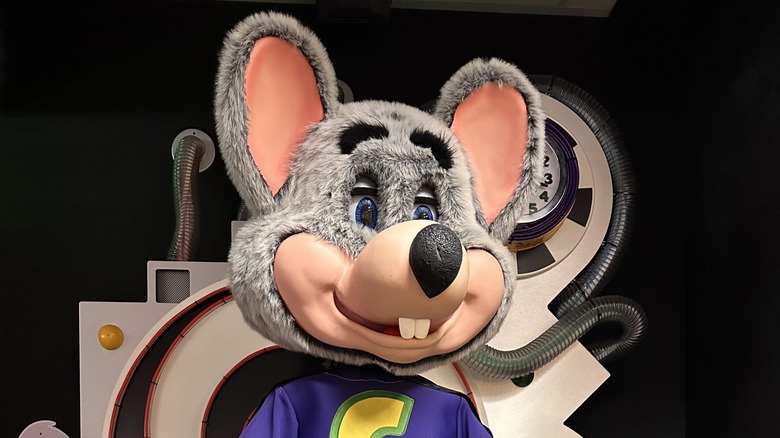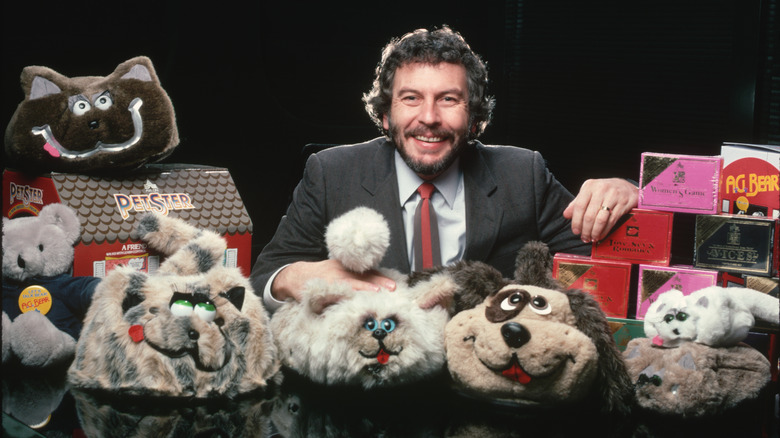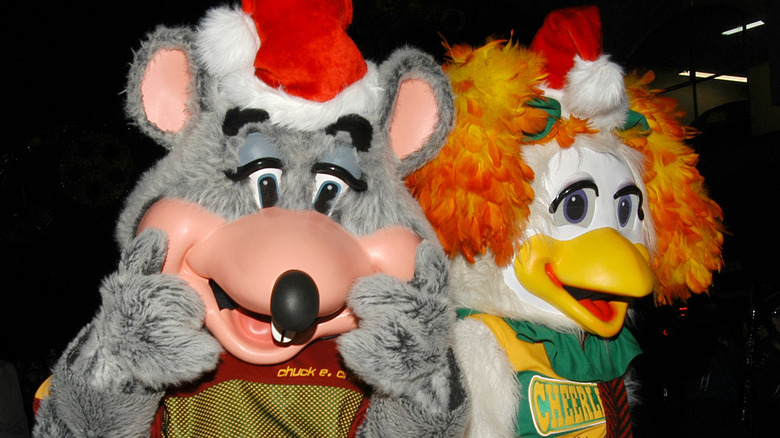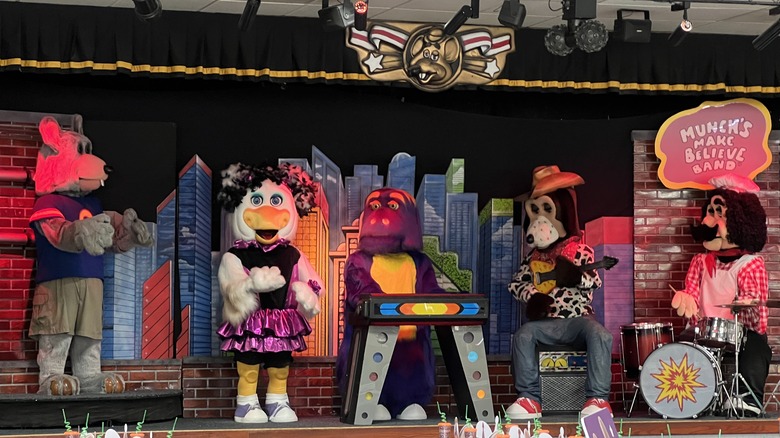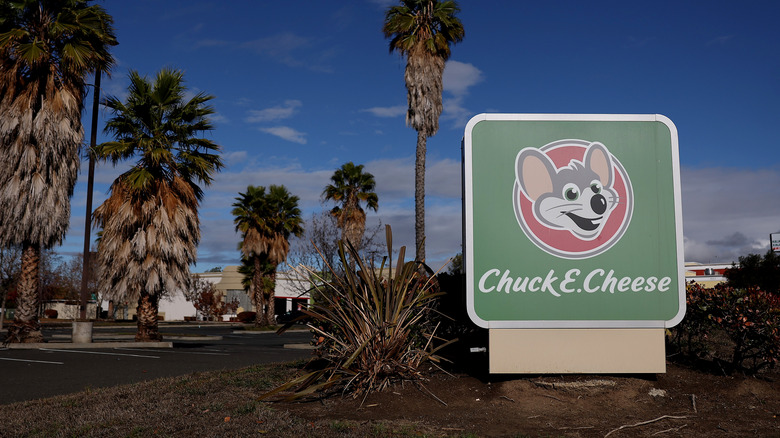The Rise And Fall Of Chuck E. Cheese's Animatronic Band
One of the first things you might think of when you hear the name Chuck E. Cheese is the animatronic band. However, there's bad news for fans of the singing animals. As first reported by The New York Times in May, the chain will be getting rid of arguably its most iconic feature at all but five of their more than 400 restaurant locations. Chuck E. Cheese plans to replace the bands with stadium-sized television screens and digital dance floors in an effort to appeal to younger generations who have been raised on digital media.
The news came as a hard hit to longtime fans of Chuck E. Cheese, whose vocal displeasure has already caused the brand to rethink its move. Originally, the company planned to retire animatronics at all but two locations, one in Los Angeles and one in Nanuet, New York. However, following backlash from fans, the brand announced that three additional locations — in Pineville, North Carolina, Hicksville, New York, and Springfield, Illinois — would also be keeping their animatronic bands.
In getting rid of its animatronic bands, Chuck E. Cheese will also be stealing a job from its own mascot. The animatronic Chuck, whose full name is Charles Entertainment Cheese, has been the band's frontman since the restaurant chain's inception, and his presence on the microphone will surely be missed. Fast food mascots seem to be dropping like flies these days; is Chuck E. Cheese's fate destined to mirror the fall of the Hamburglar, or does the rat have another act left in him? We take a look at the rise and fall of the Chuck. E Cheese animatronic band.
Chuck E. Cheese was founded by a video game pioneer
Chuck E. Cheese is the brainchild of Nolan Bushnell. As a child, Bushnell was obsessed with Disneyland, and dreamed of becoming an Imagineer (the official job title of Disney's theme park designers). He was particularly fond of the Enchanted Tiki Room, where an animatronic flock of tropical birds sings a series of tunes, accompanied by dancing flowers. This instilled an obsession with animatronics in Bushnell that would only grow stronger over the years.
In the 1970s, Bushnell co-founded the video game company Atari, and subsequently became one of the best-known figures in the burgeoning California tech scene known as Silicon Valley. Atari, with its signature "Pong" series, paved the way for today's video game industry, but it was never Bushnell's true passion. He began developing plans for a family restaurant chain that could function as a cheaper, more accessible version of Disneyland.
In part, Bushnell wanted to give Atari's arcade games, which had become associated with bars, a more family-friendly image, but he also wanted to pursue his love of animatronics. Fortune favored him when, in 1976, Warner bought Atari for $28 million. As part of the sale, Bushnell convinced Warner to fund his restaurant concept by establishing the Atari Restaurant Operating Division. He hired Gene Landrum to run the new division, and together, the two men fleshed out their vision for animatronic entertainment. They had a lot of ideas, but a rat was not one of them.
Chuck was originally supposed to be a different animal
Nolan Bushnell felt that his business needed an equivalent to Disney's Mickey Mouse, and so he started shopping around for full-body mascot costumes, and found one at an amusement show. It was a giant coyote, or so he thought, and he figured "Coyote Pizza" would be a good name for the restaurant, so he ordered one of the costumes. However, when it finally arrived, Bushnell discovered a crucial oversight. He had only seen the costume from the waist up, and assumed it was a coyote, but when he unpacked the whole thing, he found a long, pink rat tail hanging off the back. Unfazed, Bushnell decided to roll with it, and named his mascot "Rick Rat."
Meanwhile, Bushnell and Gene Landrum assembled a team to develop animatronics for the restaurant. Originally, Bushnell wanted to have singing beer barrels, but these were dropped for the more family-friendly concept of singing animals. Bushnell had all their designs based on the style of his Rick Rat costume, but not everybody was on board with the mascot's name.
There were two problems with the name "Rick Rat." Firstly, it was a little too close to Mickey Mouse, risking potential legal action from Disney. Secondly, nobody wants to hear the word "rat" when they're choosing a place to eat. Ultimately, they settled on the name Chuck E. Cheese, and positioned their mascot as the vocalist of their animatronic band.
The band members have evolved over the years
Nolan Bushnell's vision finally came to fruition in 1977 when he opened his first restaurant in San Jose, California. It was originally called "Pizza Time Theater," and was owned by Atari. There was a salad bar, pizza, a hundred arcade games, and of course, the animatronic band. The first iteration of the band was simple. Instead of having full-body animatronics, each character was surrounded by a picture frame so that only their upper halves were visible. The characters were also slightly different. Instead of Mr. Munch, there was Crusty, a black-and-white cat. Pasqually was there, and so was Jasper T. Jowls, but back then, the dog was known as "Billy 'Banjo' Boggs." Helen Henny joined later that first year.
Pizza Time Theater was an immediate success with the public, but behind the scenes, things were chaotic. Bushnell frequently clashed with Atari executives, who preferred to focus on video games. In 1978, he quit, but not before buying all of the rights to Pizza Time Theater away from Atari. Over the next few years, Bushnell opened more Pizza Time locations, expanding on his original concept. The animatronic bands were upgraded to full-body characters, and Mr. Munch replaced Crusty. During this time, Pizza Time Theater also experimented with a variety of animatronic guest stars, such as Madame Oink, a French pig, and Foxy Colleen, who sang Irish folk songs.
The downfall of Chuck E. Cheese
The tides turned against Chuck E. Cheese not long after Bushnell broke ties with Atari. A rival chain of pizza arcades opened up called ShowBiz Pizza, which featured an animatronic band called Rock-afire Explosion. ShowBiz had better animatronic technology, featuring full-body characters when many Pizza Time Theater locations still had the simple, framed portrait animatronics. Pizza Time filed for bankruptcy in 1984, and in a wild twist, ShowBiz Pizza ended up buying the company from Nolan Bushnell for $35 million.
Despite being the more successful brand, ShowBiz decided to get rid of its Rock-afire Explosion band and adopt the characters from Pizza Time. The Rock-afire animatronics were stripped of their costumes and replaced with Chuck E. Cheese and his pals, who got smoother movements thanks to ShowBiz's superior technology. The 1990s and early 2000s were arguably the heyday for Chuck E. Cheese's, but the brand has been in decline ever since.
Chuck E. Cheese repeatedly posted losses in the 2010s. The COVID-19 pandemic shut down many locations and the brand filed for bankruptcy again in 2020. They got caught running a ghost kitchen under the name Pasqually's Pizza, but now that ghost kitchens are disappearing, even those business prospects look grim. Like the recent launch of the Chuck E. Cheese adult menu, the choice to scrap the animatronic band in favor of more modern media technology is an attempt to breathe new life into the flailing brand, but in doing so it loses a huge part of the restaurant's original spirit.
